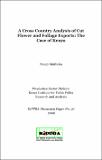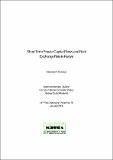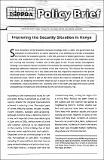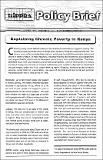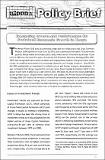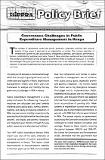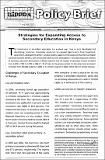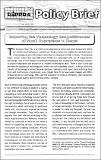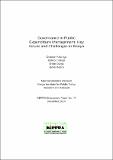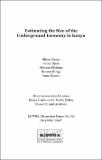3. KIPPRA Research Publications: Recent submissions
Now showing items 541-560 of 708
-
Discussion Paper No. 96 of 2008 on A Cross Country Analysis of Cut Flower and Foliage Exports: the Case of Kenya
(The Kenya Institute for Public Policy Research and Analysis (KIPPRA), 2008)In terms of volume and value, cut flowers are the single most important horticultural exports, followed by vegetables and fruits in Kenya. Floricultural trade in the country is export oriented with an end-user focus. There ... -
Discussion Paper No. 86 of 2008 on Short Term Private Capital Flows and Real Exchange Rate in Kenya
(The Kenya Institute for Public Policy Research and Analysis (KIPPRA), 2008)Kenya's capital and financial account balance displays a sharp shift in external financing from official assistance to private capital transfers in the 1990s. Whereas the capital account of the balance of payment reflects ... -
Discussion Paper No. 92 of 2008 on Assessing Oil Vulnerability: Key Indicators and Policy Options
(The Kenya Institute for Public Policy Research and Analysis, 2008)Petroleum products are a key source of commercial energy in Kenya. The economic impacts offi rst and second oil shocks of the 1970s and current volatile crude oil prices have pushed supply vulnerability to the top ... -
Policy Brief No. 07 of 2007 on Improving the Security Situation in Kenya
(The Kenya Institute for Public Policy Research and Analysis, 2007)Since the advent of the Economic Recovery Strategy (ERS) in 2003, the government has indicated its commitment to tackle insecurity in an attempt to provide a favourable environment for economic growth. In the ERS, provision ... -
Policy Brief No. 09 of 2007 on Explaining Chronic Poverty in Kenya
(The Kenya Institute for Public Policy Research and Analysis, 2007)Chronic poverty can be defined in terms of the duration households are trapped in poverty. The chronically poor are those who are always poor, or usually living below the poverty line. The chronic poor suffer persistent ... -
Policy Brief No. 15 of 2007 on Enhancing Investment Performance for Sustained Economic Growth in Kenya
(The Kenya Institute for Public Policy Research and Analysis, 2007)The Kenya Vision 2030 aims at achieving a high and non-inflationary real Gross Domestic Product (GDP) growth of 10 per cent by 2012, and sustaining it thereafter. To achieve this growth, Kenya needs to increase public ... -
Policy Brief No. 04 of 2007 on Governance Challenges in Public Expenditure Management in Kenya
(The Kenya Institute for Public Policy Research and Analysis, 2007)The concept of governance covers the social, economic, corporate, political and cultural aspects of how power is exercised in an organization or society. The common principles in the exercise of power include: accountability, ... -
Policy Brief No. 03 of 2007 on Strategies for Expanding Access to Secondary Education in Kenya
(The Kenya Institute for Public Policy Research and Analysis, 2007) -
Policy Brief No. 10 of 2007 on Improving the Technology Competitiveness of Small Enterprises in Kenya
(The Kenya Institute for Public Policy Research and Analysis, 2007)The Sessional Paper No. 2 of 2005 on Development of Micro and Small Enterprises (MSEs) for Wealth and Employment Creation for Poverty Reduction singles out restricted levels of technology as one of the major constraints ... -
Policy Brief No. 11 of 2007 on Effectiveness of Financial Sector Reforms in Promoting Domestic Private Investment in Kenya
(The Kenya Institute for Public Policy Research and Analysis, 2007)The Kenyan government has over the last decade been implementing financial sector reforms aimed at promoting private investment. The main focus of the reforms was liberalization of interest rate and exchange rate, ... -
Policy Brief No. 12 of 2007 on Subsidizing Secondary Education in Kenya:Costs,Financing Sources and Implications
(The Kenya Institute for Public Policy Research and Analysis (KIPPRA), 2007)Public intervention in the provision of secondary education is sometimes necessary to safeguard against inequalities in access given the relatively high household poverty incidence in Kenya. Furthermore, educating ... -
Policy Brief No. 08 of 2007 on Strategies for Securing Energy Supply in Kenya
(The Kenya Institute for Public Policy Research and Analysis (KIPPRA), 2007)There is a close relationship between economic growth and quality of life, on one hand, and demand for energy, on the other. Acountry cannot experience high levels of economic growth if energy supplies are constrained. ... -
Policy Brief No. 01 of 2007 on Options for Sustaining Kenya’s Economic Growth Pattern
(The Kenya Institute for Public Policy Research and Analysis (KIPPRA), 2007)Achieving sustainable economic growth in Kenya has continued to be elusive. Economic growth has been characterized by episodes of both high growth rates (1960s, 1970s and after 2003 to present) and recession (around 2000 ... -
Policy Brief No. 17 of 2007 on Enhancing Private Sector Participation in the Provision of Primary and Secondary Education in Kenya
(The Kenya Institute for Public Policy Research and Analysis (KIPPRA), 2007)The growth of private education provision since the 1990s can be associated with various factors, including education policy reforms such as the introduction of cost sharing in 1988, curriculum reform from the 7-4-2-3 ... -
Discussion Paper No. 79 of 2007 on Sources of Economic Growth in Kenya: A Redux
(The Kenya Institute for Public Policy Research and Analysis, 2007)Achieving and sustaining high levels of economic growth has been a primary focus for policy makers in post-independent Kenya. However, economic growth has been episodic, and achieving sustainable growth remains elusive. ... -
Discussion Paper No. 84 of 2007 on Technical Efficiency of Kenya's Sugar Factories: An Agenda for Enhancing Competitiveness
(The Kenya Institute for Public Policy Research and Analysis, 2007)This paper provides estimates of technical efficiency in Kenya sugar factories. It examines factors that affect technical efficiency by applying a stochastic production frontier approach over the period 1996-2005 using ... -
Discussion Paper No. 77 of 2007 on Governance in Public Expenditure Management: Key Issues and Challenges in Kenya
(The Kenya Institute for Public Policy Research and Analysis (KIPPRA), 2007)This paper develops a conceptual framework for applying good governance to systems of public expenditure management (PEM), and analyses governance in public expenditure management in Kenya. An overview of some key governance ... -
Discussion Paper No. 82 of 2007 on Estimating the Size of the Underground Economy in Kenya
(The Kenya Institute for Public Policy Research and Analysis (KIPPRA), 2007)The underground economy comprises economic activities not accounted for in national income statistics and is, therefore, difficult to measure. The difficulty arises because this economy comprises a host of traditional and ... -
Discussion Paper No. 74 of 2007 on Strategies for Securing Energy Supply in Kenya
(The Kenya Institute for Public Policy Research and Analysis, 2007)Energy fuels virtually all the systems supporting mankind, and is essential in both rural and urban areas. Lack of adequate and reliable energy supply reduces the potential/or achieving major structural changes in rural ... -
Discussion Paper No. 75 of 2007 on Free Secondary Education in Kenya: Costs, Financing Sources and Implications
(The Kenya Institute for Public Policy Research and Analysis, 2007)The study analyses the feasibility of Free Secondary Education (FSE) in Kenya. Its purpose is to present an analysis on whether Kenya can afford FSE and how such a programme can be financed without compromising the gains ...

